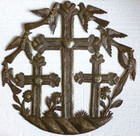Haitian Oil Drum Art
Visitors to the Noailles district of Croix-des-Bouquets know they have arrived, when they hear the beat of syncopated hammer blows from all the art studios and workshops, which line its streets. This Haitian market town just northeast of Port-du-Prince has became a world renowned center for metal art pieces, made from recycled oil drums, brought in by handcart and “tap-tap” taxi from the harbor of the capital. The trade in decorative cut-metal art provides jobs for, at least, 200 local artisans, working in some 20 studios clustered along the intersection of three main roads, running through Croix-des-Bouquets.
Metal art-making in Croix-des-Bouquet dates from the early 1950s, when Dewitt Peters, an American teacher who founded the famous Centre d’Art in Port-du-Prince in 1944 to support Haitian artists and promote their work abroad, was driving through the town and stopped to admire some unusual metal crosses in the cemetery. Peters was so impressed by these works by local blacksmith, Georges Liautaud, he encouraged him to make metal art full time.
Liautaud found the perfect material for his semi-sculptural pieces in used oil drums, which were readily available from nearby Port-du-Prince. Together with his neighbors, the Louis-Juste brothers, the blacksmith from Croix-des-Bouquets forged a unique form of Haitian folk art. This first generation of oil drum artists passed the knowledge on to apprentices, Serge Jolimeau and Gabriel Bien-Aime, who, in turn, have trained a new generation of metalworkers, represented by Michee Ramil Remy, whose oil drum cross can be found in the Sacred Art Pilgrim Collection.
Haiti’s metal artists begin by cutting the lids off the top and bottom of 55 gallon oil drums. They place the lids inside the barrels, stuff them with dried sugar cane and banana leaves, and set the oil drums on fire to burn off paint and rust markings. Once the metal has cooled, the cylinder is cut down the side and pushed, pummeled, and hammered into flat rectangular sheets, measuring about 90 x 180 cm. The flattened lids have a diameter of 61 cm. A design is chalked onto the metal using a paper pattern. Working with chisels, hammers, punch tools, and nails, the craft workers cut out the design, create concave and convex surfaces, and emboss decorative details. Sharp edges are removed with sanding and a steel wire brush, and the completed semi-sculptural pieces are treated with a protective varnish.
Working with such simple tools, the metal artists of Croix-des-Bouquets are able to create lush Trees of Life, mermaids with shimmering scales, and flaming-haired angels. Haitian art is especially rich in religious imagery, a syncretic melding of West African, French, Voodoo and Christian motifs, as can be seen in Oil Drum Artist JP Richard Derosiers' circular sculpture, Le Cross, where a man pours out a traditional Voodoo offering to the spirits of the dead at a gravesite marked by a Christian cross. The scene is framed in a metal tracery of smaller crosses.
Metalworker Zilius Muracin has hammered out a tightly composed Last Supper at his "In God We Trust" workshop. Nicolson Mathieu shows St. Francis preaching his famous sermon to the birds. Exulien Exuma depicts the Flight into Egypt in rectangular format. Most of the works on religious themes are by unknown Haitian cut-metal artisans. An elongated angel with sword expels Adam and Eve from Paradise; animals peep from the portholes of Noah’s ark; the Holy Family keeps watch by the manger under a filigree of stars; and Three Wisemen bear gifts, wearing beautifully embossed robes.
Croix-des-Bouquets served as a major resettlement center for the homeless after the devastating earthquake struck Haiti in January 2010. The town’s thriving, recycled metal art industry now offers a glimmer of hope for this poorest nation in the Western Hemisphere and has received support from international organizations like the Clinton Global Initiative, the “think tank” President Bill Clinton founded in 2005 to promote environmentally-focused development projects around the world.












